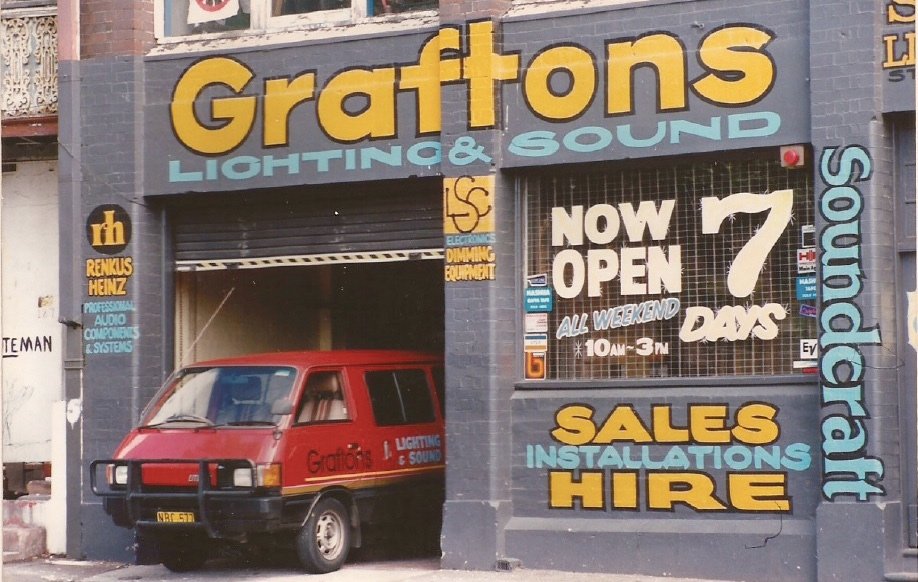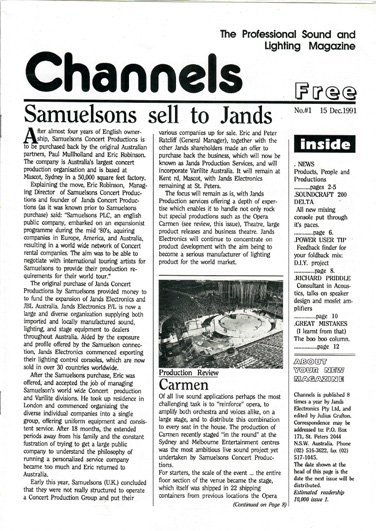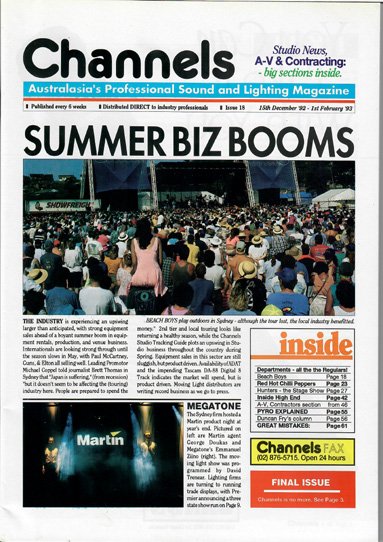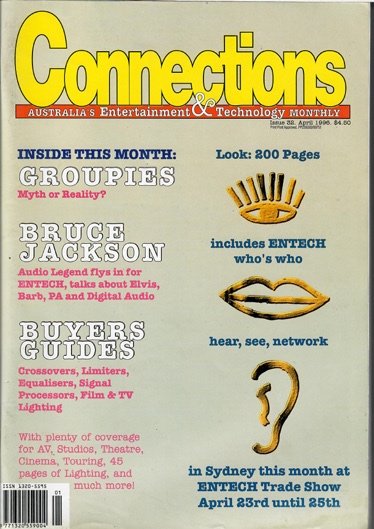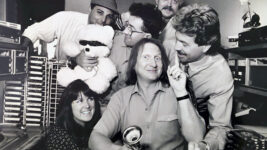News
30 Jan 2020

29 YEARS OF PUBLISHING JUST ENDED

Subscribe to CX E-News
29 YEARS OF PUBLISHING JUST ENDED
Juliusmedia and CX sold to Jason Allen.
By Julius Grafton
My media life is over – but new doors open
When I was but 10 years old, I published my own newspaper! The Balmain and Darlinghurst Eye was a kids-eye view of the monochromatic dirty streets of those slums in the 60’s, where cut-throat razors were sharp and where American G.I.’s on R&R breaks roamed both drunk and high on LSD. We lived in a hovel next to a brothel, the almost destitute children of estranged artists whose English heritage dictated that children should be seen and not heard.
The Eye attracted attention! A Daily Mirror journalist wrote it up as a curiosity piece, and I was a minor (minor) celebrity for a day and a half. A photo copier company APECO sponsored me, thinking I’d get a couple of editions (single sheet, printed both sides, circulation 25) and lose interest. A year and a half later I kept coming in, on first name terms with the staff.
My school commissioned me to publish a school newspaper, The Crown. Sounds regal but so named as the school was Crown Street Public, and I was in Year 6. The Principal and I went around the corner to 179 Campbell street and sat in the office of Mr. Papadopolous, publisher of the Greek Weekly to negotiate a print run of 500 copies. I was in the big time!
Back in those studious days of 1969 I was half educated, my math and geography were on par, my grammar and history were not. For some reason the Principal allowed me to type all my stories, and have the printer shoot them direct to film, and then onto plates. The resulting inaugural A3 sized, four-page Term 2 edition received mixed reviews, most focussing on my remarkable spelling errors and misplaced apostrophes. The next two issues were ruthlessly subbed.
At High School my interest in the “fourth estate” (as journalism was so called to emphasize the independence of the press) waned. I become more interested in girls, and rock and roll. This continues today, for some strange reason, although I’m only interested in a few girls these days – Kate, daughters, dog, nieces and grand daughter!
After being expelled from Vaucluse Boys High I had a short spell at Guriganya Alternative School for dope smoking hippy parents in Paddington. It was instructive – shoes optional, nudity possible, and relentless boredom probable. Once I turned 15 I got a job as a copy boy at News Limited and worked the morning shift on the Daily Mirror.
The pathway to a journalism cadetship was the copyboy office where two overworked clerks fielded demands from every department for boys to run stuff everywhere. My least favourite place was the typesetting hall, which was hot, loud and staffed by tradies who hated everyone. My most favourite place where I spent most of my time was the typing pool.
I loved the girls, and they sort of liked me a little. Up to eight of them sat four a side of a central conveyer onto which they would chuck each forme. A flack would call in and dictate a story from a public phone. The girls wore Bakelite headsets and typed each paragraph onto a continual feed forme set which comprised four different coloured sheets with three sets of carbon paper. Each forme was perforated, so they would tear it off and chuck it on the belt.
Little Julius would assemble each story in piles. Each forme had a code at the top and a sequential number so the dumbknut copyboy could get it right. Within two minutes my fingers were black with carbon paper which needed to be cleaned off to avoid too many smudges on the formes. When complete, the four different coloured piles of the same story were stapled together and I would RUN them to the sub desk, the editor, the news desk and the archive desk. Then back to find a pile more stacking up.
There were generally three or four girls working but if something huge happened, all eight places were filled, and a second boy came on to run the stories out. These things happened on my shifts in 1972 (as reported in Wikipedia):
- 15 November – First aircraft hijacking in Australia. Ansett Airlines Flight 232 from Adelaide to Alice Springs with 28 passengers and a crew of 4. Followed by gun battle at Alice Springs Airport.
- 1 December – Belinda Green is crowned Miss World in London, becoming the second Australian winner of this pageant. Australia won the two most important beauty contest in this year. (I went down to the photo library to check her out. Hubba-hubba!)
- 2 December – 1972 Australian federal election: The Labor Party led by Gough Whitlam defeats the Liberal/Country Coalition Government led by Prime Minister William McMahon. Consequently, Whitlam becomes the first Labor Prime Minister of Australia since the defeat of Ben Chifley in 1949.
One day Thomas the too tall senior copy boy pulled a prank on me by calling Rosie, the lead stenographer during his tea break from the canteen phone and feeding me a dumb story. It went something like;
GRAVEDIGGERS STRIKE
The New South Wales Alumni of Gravediggers have walked off the job at Rookwood Cemetery today. Head digger Clarry Dirtwater told The Mirror that the men had a bone to pick.
“The situation is grave”, he said… and so it went for five pars of bad puns.
Little Julius put it together and ran it out to the desks. Three minutes later, Monkey Man the lead sub editor burst thru the barn doors and yelled at me “WHO DID THIS SHIT?” Rosie was laughing her arse off.
The daily life at the Daily Mirror went like this: morning shift started at 5am. First edition went to press at 9.15am, and the reporters all retired to the pub for a few. Refuelled they would work up the Final Edition by 11.30, and the Late Final Extra by 1pm. If some manure hit a fan somewhere they would keep going. The ‘Stop Press!’ bell had everyone in the building (except the denizens of mahogany row) on high alert. It happened infrequently because it added a lot of cost the operation.
It was amazing how fast the whole thing came together, and that instilled a value into that I hold dearly today. ‘The Show Must Go On’ came later when I branched off into lighting, adding on the ‘Just Do It Now’ ethos of the newspaper gave me a real drive for deadlines.
The pathway to cadet involved a period of character building in the Sports Department where some serious hazing went on. I watched with looming terror the soul destruction dished out on senior copy boys to break them or make them. The survivors inevitably became cadets, tasked to the obituary desk or on secondment to the gardening page.
Rock and roll beckoned, and I quit the newspaper, registering Zapco Lightshow on March 1, 1973. I was off and running, doing psychedelic lightshows, lighting bands, theatre, fashion parades and one memorable Easter Show working alongside Tommy The Sea Lion! He had a bad attitude – and bad breath. I kept well clear; wiping the fish entrails off my cables every night.
RETURN TO THE TYPEWRITER
Late 1970’s I was running Barratt Lighting for the late and great Roger Barratt. We were on a roll distributing lighting equipment built next door to our Chippendale warehouse by Richard White who ran Rock Industries. Today Richard is the CEO of Wisetech Global, an 8-billion-dollar software company around the corner from Jands in Sydney. He also just happens to own a non-controlling pile of Jands shares.
Starting with winchup stands and box truss, we made and sold Par 64 cans, downsized and launched the Par 56 as a stage light, Pin Beams, Raylights, and some problematic spinning disco effects. Sales of all this stuff took off in 1980, and I started writing a page called ‘SHINE ON’ for the industry magazine called SONICS.
After four years of touring production I opened Graftons Sound and Lighting and ironically one of our two warehouses on Campbell Street Surry Hills was the former printery of Greek News! I published a lot of company newsletters.
In 1989 I ‘retired’ burned out, had a sabbatical out under a mountain near Bathurst and build a family log cabin. Winter 1990 I was doing sound for a band from out west who won a place in the Yamaha Band Competition and we did the rehearsals at Selina’s on a Saturday afternoon. With time to kill, on a whim I went to a music equipment tradeshow at the old Sydney Showgrounds and ran into Peter Twartz from Jands.
He said that by chance he had just been talking about me with Paul Mulholland, the Jands CEO who in turn had a conversation with Phil Tripp, the top music industry publicist at that time. Tripp had said Jands had so much going on they should publish their own magazine. Paul liked the idea, Peter said he should find and talk to me.
So that’s how the fibres of an idea knit together – I was highly interested and enthusiastic and hounded Paul until he hired me on contract to publish a Jands company magazine. It was called Channels, and over 2 years it became a monster – growing for 8 black and white pages, to 64 pages with some in full colour. The tide turned when I started selling advertising – to Jands competitors. Paul was all for it, some in Jands were not.
Channels got too big for a company magazine and I approached Paul to negotiate an exit to publish my own magazine. He embraced the idea, which was a massive relief, and sold me the mailing list from Channels so we had a running start.
MAGAZINE PUBLISHING
Connections first appeared in February 1993 as a monthly magazine and it took off. We were running $60,000 worth of ads each edition and almost every importer and distributor in the business were on board. Pretty soon the seed was sown for ENTECH which came along in October 1994, a large format 3 day tradeshow.
Connections grew and grew, it was a partnership between my then wife Caroline, who sold the adverts and myself running editorial. It was labour intensive as we were in the first generation of desktop publishing and needed every photo scanned to film. The four colour printing of the time also needed film – 4 sets, one for Cyan, one for Magenta, Yellow and Black – CMYC. From film the printer then produced four plates.
Email and the world wide web came along and things changed for the better. Desktop scanners became more affordable, but those mid 1990’s provided a lot of technical challenges. One of them was file transfers – we would load the files onto a Jazz drive and later a Magneto Optical cartridge, and drive them across town to the reprographics house.
Those guys transformed our Pagemaker files into plate-ready film; which took about 3 working days and cost north of $7,000 an edition. The printer then made plates and ran the presses for 10,000 copies. We trucked 7,000 to a newsagent distributor, and then bulk mailed 3,000 to our subscribers.
To get the time cycle down we did our own mail bagging and sorting the very same day (night) of delivery from the printer. 75 cartons of magazines, almost a tonne, were bagged in a recyclable paper mailing bag and usually we added an insert of some kind. The mail labels were in postcode ranges, and the postcode sort that Australia Post required was complicated. Each postcode region had a separate regulation Australia Post tub.
The bagging and sorting was done by a crew controlled by our dear friend Ruth McKinnon. She would rope in nine or ten people, we would pay them all and stop for pizza half way through the process, which often finished after 10pm.
Next morning I’d load all the tubs into a rental van and drive them to the Australia Post depot, where time consuming paperwork would be done and an eye-watering payment made. ‘Print Post’ was relatively fast in that ancient era, compared to the snail mail our magazine endures today.
The printer would return the film sets to us, and our advertising art co-ordinator would strip out all the adverts so we could re-use them to save the advertiser the cost of film duplication if they wanted to repeat an advert.
I was doing most of the layout using Pagemaker on the Mac, and then had Cat Strom do her own layouts for the Lighting section. We worked well together. In the office we had a bookkeeper 3 days a week, an office manager, junior, the advertising art co-ordinator, and a cadet journalist. It was hard work.
CX IS BORN
Once year 2000 came along everything changed as the partnership broke down. Cat Strom left. Caroline sold out to me, and I took on the advertising sales for a few years until Steve James came along. In 2002 we rebranded as CX Magazine and changed the frequency to bi-monthly. This was because I was consumed in the horrendously complicated world of running a Registered Training Organisation, which seemed like a good idea at the time.
The demand was there to lift the frequency to 8 x yearly, which meant a magazine every 6 weeks, which is clunky. The printing firm bought a ‘digital direct’ press so we could skip the film reprographics process which cut 3 days out of the production cycle. The newsagent distributors got lazy and inflexible and Australia Post kept changing the rules with Print Post.
Seizing on the 3 day time saved, we ditched the DIY mail bagging and sent the work to a mailing house which sometimes took longer than contracted. One memorable month, we tried a sheltered workshop (so called at the time) and not only was the mailing delayed a week but readers were calling to report food remnants like hundreds-and-thousands, from a frosted donut, were in the bags!
In 2004 I sold ENTECH to ETF, investing the money back into the college.
Though the mid 2000’s CX struggled as I was so distracted by the college. It burned me up to have my passion for media dampened by the horrors of accredited training compliance. Eventually the college fizzled out and I did an orderly shutdown at the end of 2010. Moving in to new premises at Chatswood, I found myself emotionally depleted and exhausted in January 2011. To get the February edition up, I had to find the edge again. The college had sent me personally broke, I had a crappy second hand car, a marriage in trouble, two boys and two dogs to feed. I was depressed, and I don’t do depressed.
Jimmy Den Ouden and Steve James rallied around me and lifted me up. I took a cheap flight at 6am to Melbourne to visit my neglected advertising clients. Peter Troy and Graeme Stevenson in particular both encouraged and backed me, as did others. I was back! Cat Strom returned and added her unique angle to our media. Things slowly got better. Graeme suggested the concept what would become CX Summer Roadshow, and I started planning that for February 2012.
The roadshow took off, then in 2013 my third marriage collapsed and I had to go rent somewhere which led me back to a very different Balmain. Late that year I got Prostate Cancer. After having that removed and getting a clean bill of health I met Kate in 2014, and things literally took off.
In 2015 I bought ENTECH back from ETF for 1.5c in the dollar, rebranded the roadshow, added another one called SECTECH (a partnership). And CX found an editor in early 2018 when Jason Allen took on the challenge.
JULIUSMEDIA SELLS TO JASON
Given total autonomy over the media in 2018, by the end of 2019 I wanted out so I sold the business to Jason. The deal was inked in January so he could commence his new media company with the February edition of CX. You’re reading this in his pages. I’m out.
Kate and I are busy with ENTECH in Australia and NZ, and SECTECH. I run my advisory firm, Julius Partners, which led me to Carmen Figueroa and House of Soul Australia. Rather than advise her I liked it so much I partnered up, and then we were asked to promote Hindley Street Country Club in NSW. That arrangement has expanded, so the music promotor part of our business is quite time consuming.
I’m still around, Jason may use some of my articles from time to time, and reject some as he has already been doing. I know Juliusmedia and CX Magazine are in the best of hands. Jason is passionate, he has a great media and marketing mind, and indeed a brilliant brain. I hope he does incredibly well, and I know he already works insane hours on this media.
Reflecting back over almost 30 years of publishing is not a sentimental journey. I loved most of it, sometimes I made bad calls and picked the wrong fights. I grew so much through all this. My passion for the common man and social equity found a great outlet and I’m sure that I helped lift professional standards in our industry.
The Juliusmedia website was rebuilt by Jason at the end of 2019 and it now has almost all our back issues indexed so you can search thousands of articles and millions of words.
I’d like to pay tribute to Caroline Grafton (RIP) without whom this media would not have happened. Special thanks to Paul Mulholland at Jands for the turbo start, Cat Strom for so many years of collegial support and work, and Steve James for keeping it all together through thick and thin. Andy McKenzie and John Grimshaw both edited the magazine at different and difficult times. Every reader and advertiser who’ve been in the journey: thank you.
Media in 2020 is not easy, but it is needed more than ever as disinformation can be so easily propagated.
You are in the best of hands.
CX MAGAZINE – FEBRUARY 2020
LIGHTING | AUDIO | VIDEO | STAGING | INTEGRATION

ENTERTAINMENT TECHNOLOGY NEWS AND ISSUES FOR AUSTRALIA AND NEW ZEALAND
– IN PRINT AND FREE ONLINE WWW.JULIUSMEDIA.COM
© VCS CREATIVE PUBLISHING
Subscribe
Published monthly since 1991, our famous AV industry magazine is free for download or pay for print. Subscribers also receive CX News, our free weekly email with the latest industry news and jobs.






